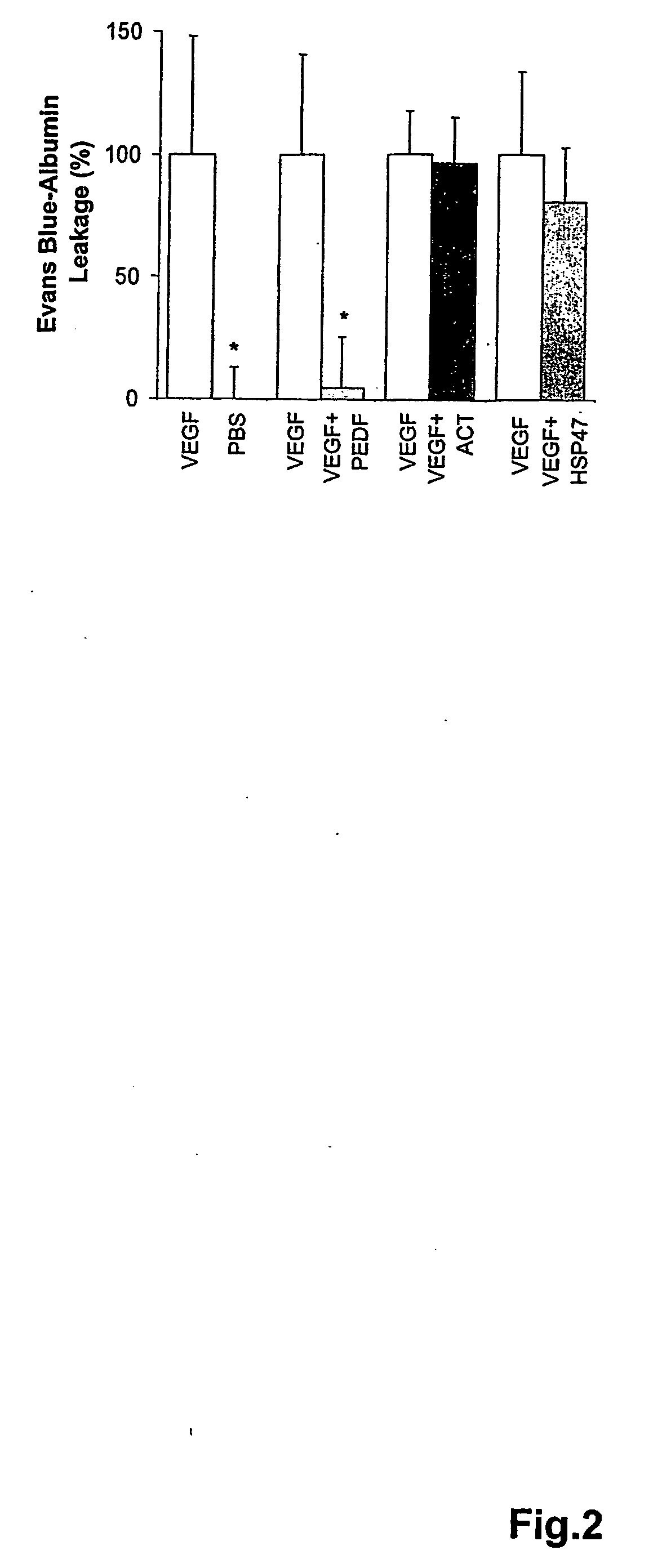Pigment epithelium-derived factor as a therapeutic agent for vascular leakage
a technology of vascular leakage and pigment epithelium, which is applied in the direction of extracellular fluid disorder, metabolic disorder, instruments, etc., can solve the problems of unable to determine whether vascular permeability can be downregulated, and how vascular integrity is maintained, so as to effectively abate vegf-induced vascular permeability and improve vascular permeability. , the effect of restoring vision loss
- Summary
- Abstract
- Description
- Claims
- Application Information
AI Technical Summary
Benefits of technology
Problems solved by technology
Method used
Image
Examples
example 1
PEDF Inhibits VEGF-Induced Retinal Vascular Permeability Qualitatively
[0168]Fluorescein angiography, a clinical diagnostic technique, allows us to see photographically the effect of factors that modulate VEGF-induced permeability. Decreased fluorescence of one eye relative to the contralateral eye can be attributed to agents injected into the 2 eyes. Since VEGF promotes vascular permeability28, there was, as expected, increased fluorescein leakage in the eye receiving VEGF164 (the murine ortholog of human VEGF165) when compared to the saline injected contralateral eye (FIG. 1a). The VEGF-induced vascular permeability was not observed when PEDF was co-injected with VEGF164 (FIG. 1b).
[0169]To show that the anti-vasopermeability activity was specific to PEDF, we tested the effect of ACT and HSP47 in the same assay. ACT and HSP47 are from two subfamilies of the serpin superfamily29, distinct from the subfamily to which PEDF belongs. Despite the high level of structural conservation amon...
example 2
PEDF Inhibits VEGF-Induced Retinal Vascular Permeability Quantitatively
[0170]To quantify and confirm PEDF's ability to inhibit VEGF-induced vascular permeability, we used a modified Evans blue assay32. Mice, injected intravitreally as in the fluorescein angiography experiments, received intravascular Evans blue 24 hours later. PEDF nearly abolished (95.6±21.2%) the VEGF-induced permeability, whereas ACT and HSP47 had no discernible effect (inhibition of 3.4±18.2% and 19.4±22.3% respectively) (FIG. 2). These data corroborate quantitatively what we observed qualitatively by fluorescein angiography: PEDF inhibits VEGF-induced retinal vascular permeability.
example 3
PEDFpep Inhibits VEGF-Induced Vascular Permeability
[0171]Because PEDF's neurotrophic / neuroprotective activity has been attributed to a 44-amino acid region24,25, we asked whether this region also possesses the permeability modulating activity. PEDFpep, which consists of amino acid residues 78-121 of human PEDF, was injected intravitreally in place of, and in equimolar amounts as full-length PEDF. The peptide effectively inhibited VEGF-induced vascular permeability in the fluorescein angiographic assay (FIG. 3a). A 46-amino acid peptide from the corresponding region of ACT (positions 73-118, designated ACTpep) had no effect on VEGF-induced vascular permeability.
[0172]The Evans blue assay corroborated the fluorescein angiographic findings (FIG. 3b). PEDFpep blocked 83.7±17.1% of VEGF-induced retinal vascular permeability to Evans blue-albumin. Similar to full-length ACT, ACTpep, did not inhibit VEGF-induced vascular permeability (−26.4±34.3%). Full-length PEDF and PEDFpep at equimolar...
PUM
| Property | Measurement | Unit |
|---|---|---|
| temperature | aaaaa | aaaaa |
| temperature | aaaaa | aaaaa |
| w/w | aaaaa | aaaaa |
Abstract
Description
Claims
Application Information
 Login to View More
Login to View More - R&D
- Intellectual Property
- Life Sciences
- Materials
- Tech Scout
- Unparalleled Data Quality
- Higher Quality Content
- 60% Fewer Hallucinations
Browse by: Latest US Patents, China's latest patents, Technical Efficacy Thesaurus, Application Domain, Technology Topic, Popular Technical Reports.
© 2025 PatSnap. All rights reserved.Legal|Privacy policy|Modern Slavery Act Transparency Statement|Sitemap|About US| Contact US: help@patsnap.com



